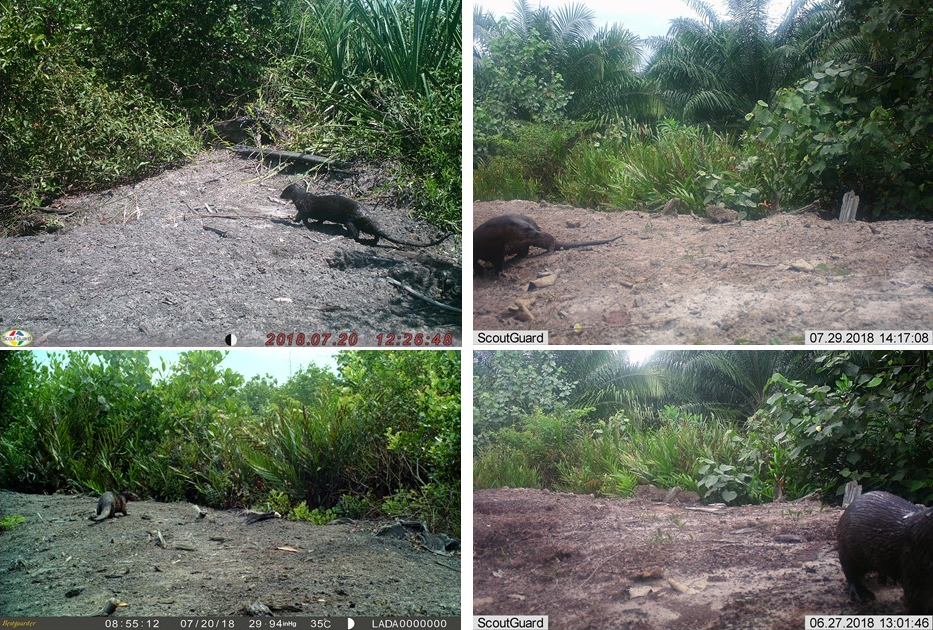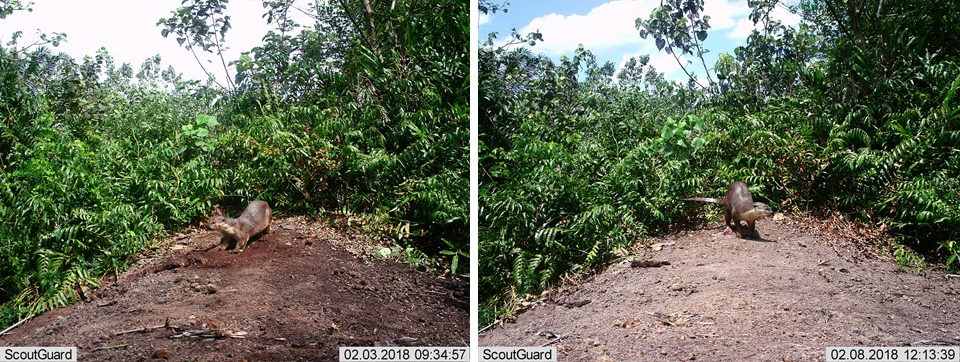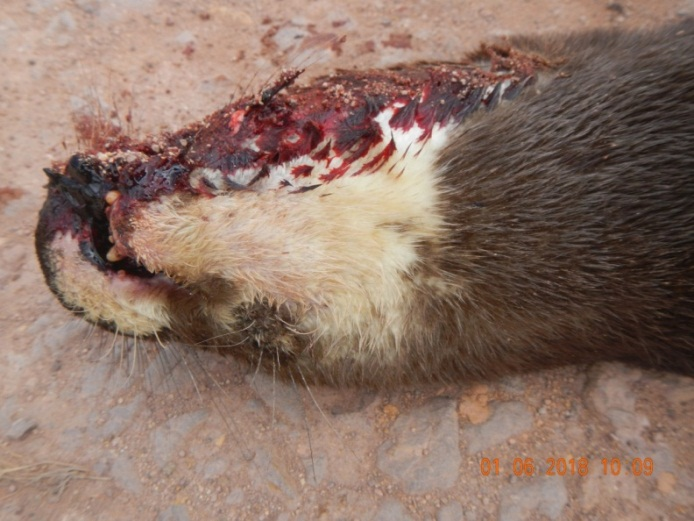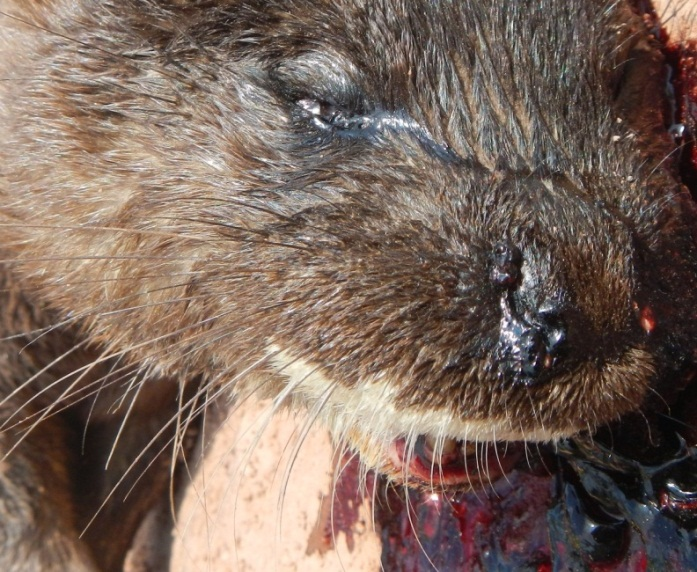IUCN/SSC Otter Specialist Group Bulletin

©IUCN/SCC Otter Specialist Group
Volume 36 Issue 2 (April 2019)
Citation: Huda, M., Fauzil, A.F., Amran, A.I., Traeholt. C. and Silmi, M. (2019). First Record of Hairy-Nosed Otter (Lutra sumatrana) in Southern Central Kalimantan, Indonesia . IUCN Otter Spec. Group Bull. 36 (2): 98 - 102
First Record of Hairy-Nosed Otter (Lutra sumatrana) in Southern Central Kalimantan, Indonesia
Mahfud Huda1, Aldino F. Fauzil1, Ali I. Amran1, Carl Traeholt2 and Muhammad Silmi1
1Biodiversity Division, United Plantations - PT Surya Sawit Sejati. Kalimantan Tengah, Indonesia
2Copenhagen Zoo, Research and Conservation Division, Southeast Asia Programme, Malaysia Email: ctraeholt@gmail.com
Received 19th April 2019, accepted 3rd June 2019
Abstract: The Hairy-nosed otter (Lutra sumatrana) has never been recorded in Borneo’s far south. Here we present evidence of the first records of Hairy-nosed otter in the southern parts of Central Kalimantan, Indonesia..
Keywords: Hairy-nosed otter, Kalimantan, Borneo, Indonesia
INTRODUCTION
The Hairy-nosed otter (Lutra sumatrana) is one of Indonesia’s four species of otter (Phillipps and Phillips, 2016) and one of the rarest of the world’s 13 otter species. It can be difficult to find and identify in the field, due to its elusive nature. It is listed as Endangered on the IUCN Red List (Aadrean et al., 2015) and is threatened by habitat loss and hunting (Wright et al., 2008; IUCN, 2018).
The Hairy-nosed otter has been recorded in scattered localities in Thailand, Indonesia, Vietnam, Cambodia, Singapore and Malaysia (Fernandez et al., 2018; IUCN, 2018; Theng and Sivasothi, 2016). In Indonesia, it is recorded from Tamling in Bukit Barisan Selatan National Park, Sumatra (Latifiana, 2013) and Borneo (Payne et al., 1985, Sasaki et al., 2009) up to an altitude of 1,200 meters asl in Pa Umur in the Kelabit highlands (Davis, 1958). It was also captured on camera traps in Sabah’s Deramakot Forest Reserve in 2010 (Wilting et al., 2010) and another individual was photographed in the Lower Segama area in 2016 (Ishigami et al., 2017). To date, there have only been two records (skins and skulls) from the Indonesian part of Borneo, Kalimantan, at the Sama River and Pulo Saparo River near Pontianak (Sasaki et al., 2009).
On Borneo, the species is recorded mainly in the northern part of Borneo, especially in Sabah (Wilting et al., 2010; Wright et al., 2008) and Brunei (Ishigami et al., 2017; Phillipps and Phillips, 2016). To date, there has been no record of this species in the southern part of Borneo, south of the 01°15'00.00"S line.
METHODS AND RESULTS
Study site
This study took place in Lada Estate, Central Kalimantan Province, Indonesia (02˚34̍53̎ S, 111˚46̍21̎ E) (Fig. 1). The habitat consists of 5000 ha palm oil estate, surrounded by approx. 1179 ha mangroves, small patches of peat-swamp and lowland dry dipterocarp forests. The landscape contains several small rivers and streams that run into the large Kumai River. The area experiences a wet season (November to April) and a dry season (May to October) with temperatures ranging from 26-34 °C and a mean annual precipitation 2123 mm.
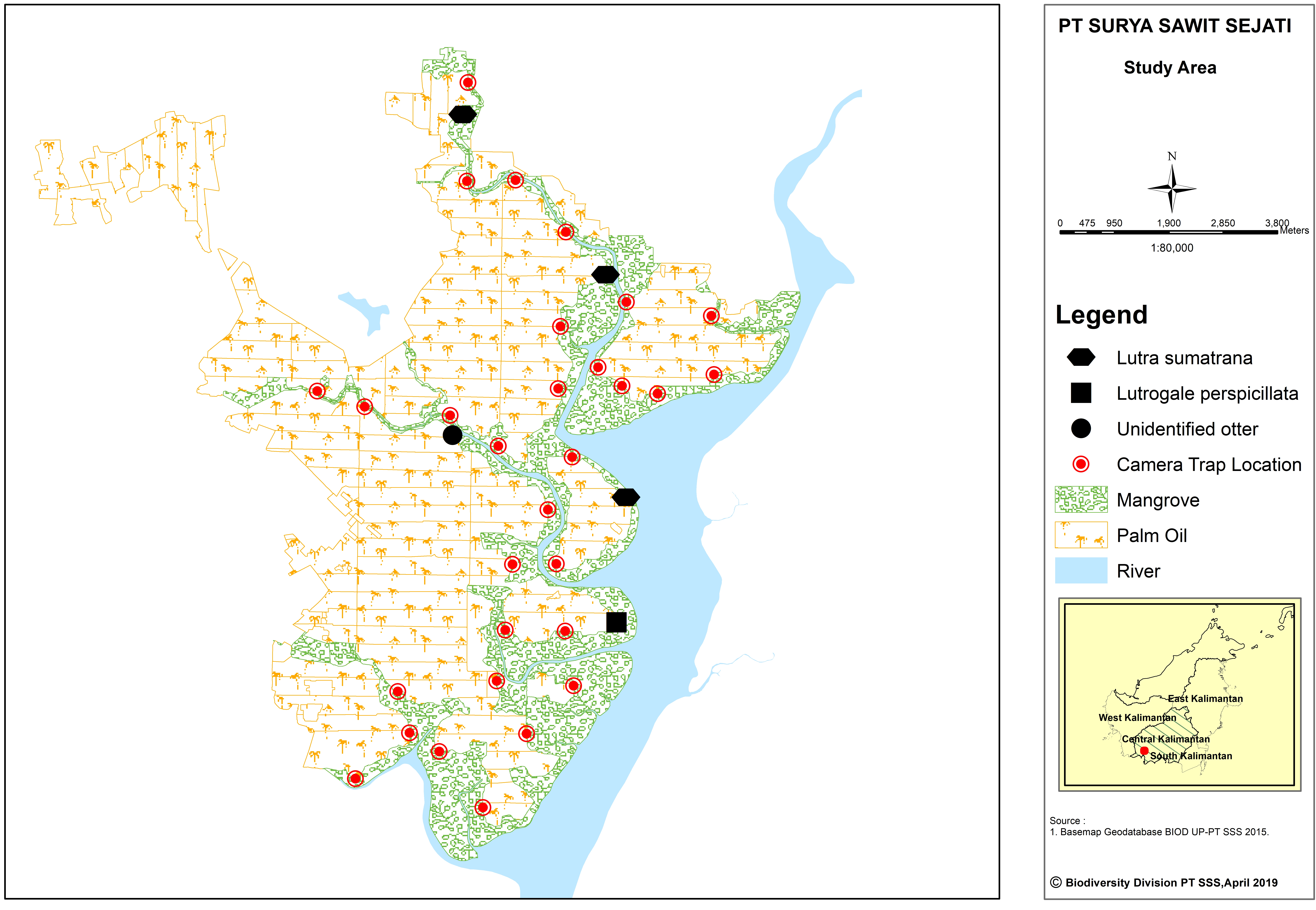
Camera-trap survey
A total of 35 camera traps (Scout Guard DTC-565V-8M Series) were deployed in grids with cells of 800 m x 800 m. Each camera trap was set to take two pictures per trigger event. Camera-traps were setup approx. 50 cm above ground on man-made bunds in the transition zone between areas planted with oil palm and mangrove forest. If there was no bush/tree available, a wooden pole was used as anchor point for the camera.
A total of 1304 trap nights produced 760 notionally independent pictures representing 26 species. A total of 7 photos were of otters, of which four were identified as hairy-nosed otters (Fig. 2) and two were that of smooth-coated otters, Lutrogale perspicillata (Fig. 3) with one of an unidentified species. The Hairy-nosed otters were recorded on camera traps from three different locations (Fig. 1).
On the 1st June, 2018, patrolling conservation officers found a recently road-killed Hairy-nosed otter (Fig. 4-6). It was discovered on the main estate road adjacent to a mangrove conservation area (02°31̍07.2̎ S; 111°49̍19.1̎ E). The specimen was an adult male (Table 1).
| Table 1: Morphometric measurements of an adult male hairy-nosed otter | |
| Category | Size |
| Body Length | 63 cm |
| Tail Length | 43 cm |
| Total Length | 122 cm |
| Weight | 8.5 kg |
DISCUSSION
Mangrove habitat forms an important habitat for the conservation of otters in Southeast Asia (Foster-Turley, 1992). However, our recent find adds more information to suggest that the species is adaptable to a variety of climate scenarios. Whereas our study areas are always water-logged (mangrove, wetlands), there is a significant seasonal variation between wet and dry season, with the latter often extending 5-6 months.
The hairy-nosed otter is the rarest of the tropical Asian otter species. It is not yet known whether the limited number of records is due to very few dedicated surveys, because of its tendency to inhabit remote and difficult to access areas. With the recent large scale agricultural development in Sumatra and Borneo, more habitats have become accessible to biodiversity survey. Consequently, in Sumatra, hairy-nosed otters have been found in a landscape consisting of swamp forests, mangroves and palm oil plantations (Latifiana, 2013). Our recent finding in a similar habitat in the southern part of Central Kalimantan suggests that, while hairy-nosed otters remain uncommon, the species’ dispersal area may be much larger than previously expected. The absence of previous records from this area is likely to have been due to lack of surveys and, with more dedicated surveys across Kalimantan, the species will likely appear in many other places with suitable habitat in southern Kalimantan.
Acknowledgements: We would like to express our gratitude to PT. Surya Sawit Sejati for making available the necessary resources for the study and to the estate manager at Lada Estate Mr. Ramadevan for his contribution to the coordination and execution of the study.
REFERENCES
Aadrean, A., Kanchanasaka, B., Heng, S., Reza Lubis, I., de Silva, P., Olsson, A. (2015). Lutra sumatrana. The IUCN Red List of Threatened Species 2015. http://www.redlist.org [accessed 14 September 2018].
Davis, D.D.(1958) Mammals of the Kelabit plateau, northern Sarawak. Fieldiana, Zoology 39: 119-147.
Fernandez, K. (2018). Status Of The Hairy-Nosed Otter (Lutra sumatrana) in Peninsular Malaysia. IUCN Otter Spec. Group Bull 35(2): 85-96.
Foster-Turley, P.A. (1992). Conservation aspects of the ecology of Asian small-clawed and smooth otters on the Malay Peninsula. IUCN Otter Spec. Group Bull 7: 26-29.
Ishigami, J., Ambu, L.N., Tuuga, A., Tsubouchi, T. (2017). The Second Recent Record of Hairy-Nosed Otter (Lutra sumatrana) in Sabah, Malaysia. IUCN Otter Spec. Group Bull. 34 (1): 67-72
IUCN (2018). 2018 IUCN Red List of Threatened Species. Http://www.redlist.org [accessed 14 September 2018].
Latifiana, K., Pickles, R.S.A. (2013). New observation of the hairy-nosed otter (Lutra sumatrana) in Sumatra. IUCN Otter Spec. Group Bull 30(2): 119-123.
Payne, J., Francis, C.M., Phillipps, K. (1985). A Field Guide to the Mammals of Borneo. The Sabah Society, Kota Kinabalu, Malaysia.
Phillipps, Q., Phillipps, K. (2016). Phillipps Field Guide to The Mammals of Borneo (Sabah, Sarawak and Kalimantan). Natural History Publications (Borneo), Kota Kinabalu, Malaysia.
Sasaki, H., Burhanuddin, M.N., Budsabong, K. (2009). Past and present distribution of the Hairy-nosed Otter Lutra sumatrana Gray 1865. Mammal Study 34: 223-229.
Theng, M., Sivasothi, N. (2016). The Smooth-coated otter Lutrogale perspicillata (Mammalia : Mustelidae) in Singapore: establishment and expansion in natural and semi-urban environments. IUCN Otter Spec. Group Bull 33(1): 37-49.
Wilting, A., Samejima, H., Mohamed, A. (2010). Diversity of Bornean viverrids and other small carnivores in Deramakot Forest Reserve, Sabah, Malaysia. Small Carnivore Conservation, 42: 10-13
Wright, L., Olsson, A., Kanchanasaka, B. (2008). A working review of the hairy-nosed otter (Lutra sumatrana). IUCN Otter Spec. Group Bull 25: 38-59.
Résumé : Premier Enregistrement de la Loutre de Sumatra (Lutra sumatrana) dans le Sud du Kalimantan Central en Indonésie
La loutre de Sumatra (Lutra sumatrana) n’a jamais été photographiée dans l’extrême Sud de Bornéo. Nous présentons ici les preuves des premiers enregistrements de loutre de Sumatra dans le sud de la province du Kalimantan central, en Indonésie.
Revenez au dessus
Resumen: Primer Registro de Nutria de Sumatra (Lutra sumatrana) Een Kalimantan Sud-Central, Indonesia
La nutria de Sumatra (Lutra sumatrana) nunca fue registrada en la parte sur de Borneo. Aquí presentamos evidencia de los primeros registros de esta especie en las porciones sur de Kalimantan Central, Indonesia.
Vuelva a la tapa
